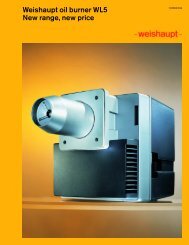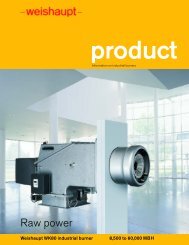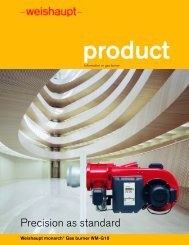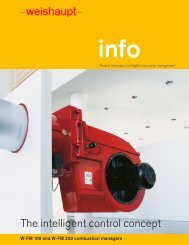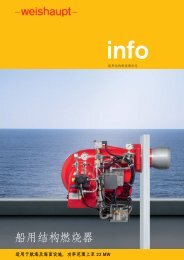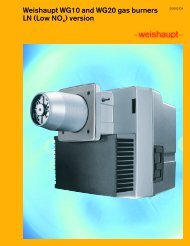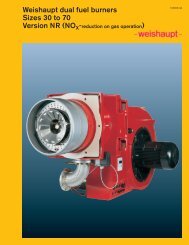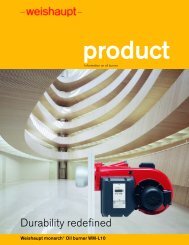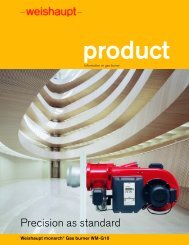Download brochure 1.8 MB (pdf) - Weishaupt
Download brochure 1.8 MB (pdf) - Weishaupt
Download brochure 1.8 MB (pdf) - Weishaupt
- No tags were found...
Create successful ePaper yourself
Turn your PDF publications into a flip-book with our unique Google optimized e-Paper software.
Description, Types of regulation,<br />
Model overview<br />
<strong>Weishaupt</strong> Monarch oil burners are of<br />
the fully automatic pressure atomizing<br />
type. Their design has been carefully<br />
considered down to the smallest<br />
detail and has been proven to be<br />
successful over and over again. They<br />
meet all the demands for safety,<br />
reliability and low cost operation.<br />
The burners are distinguished by a<br />
variety of excellent features:<br />
■ Larger range of application<br />
4 - 127 GPH (600 - 18,500 <strong>MB</strong>H)<br />
■ Automatic sequence of operations<br />
■ Stable fan characteristics - good<br />
combustion results<br />
■ Air damper closed on burner<br />
shutdown<br />
■ Quiet operation<br />
■ Complete pre-wired integral<br />
switchgear/ ISG version (except for<br />
RL, RMS and L10T three stage<br />
burners)<br />
■ Hinged burner casing<br />
■ Combustion head can be pulled out<br />
when the burner is hinged open (sizes<br />
9 to 11)<br />
■ The design of the burner makes<br />
installation, adjustment and servicing<br />
easy<br />
Construction<br />
All the components are assembled in one<br />
unit. The motor drives the fan and the fuel<br />
pump. All the equipment used for the<br />
regulation of fuel and air is clearly<br />
arranged and easily accessible. The<br />
burners can be hinged open to the left or<br />
right, which simplifies service work on<br />
the combustion head, diffuser, nozzles<br />
and ignition electrodes.<br />
Application<br />
The burners can be used on hot water<br />
boilers, steam boilers, air heaters and for<br />
various heating processes. RL and RMS<br />
burners are preferably used where there<br />
is a continually changing heat demand.<br />
Fuels<br />
Light oil #2 to Heavy oil #6 fuel.<br />
Viscosity:<br />
Types Monarch L and RL -<br />
up to 6 cSt (6 mm 2 /s) at 68F (20°C)<br />
Type Monarch M -<br />
up to 75 cSt (75 mm 2 /s) at 122F (50°C)<br />
Types Monarch MS and RMS -<br />
up to 50 cSt (50 mm 2 /s) at 212F<br />
(100°C)<br />
Regulation<br />
On L , M and MS type burners, the<br />
regulation of oil and air takes place as<br />
follows:<br />
■ two stage, nozzle head with two<br />
nozzles and a motor controlled,<br />
quickly opening air damper.<br />
■ three stage, with three nozzles and a<br />
motor controlled, slowly opening air<br />
damper.<br />
For RL and RMS burners, fuel and air are<br />
controlled in compound. The burner can,<br />
depending on the controller and<br />
servomotor, be either:<br />
■ sliding two stage<br />
(servomotor with 20 s running time)<br />
■ modulating<br />
(servomotor with 42 s running time)<br />
With sliding two stage regulation, the low<br />
and high fire positions are fixed within the<br />
burner operating range. The burner<br />
slides to one position or the other,<br />
depending on the appliance demand,<br />
and there are no rapid changes of fuel<br />
throughput.<br />
By utilizing a suitable controller, the<br />
burner can be operated in modulating<br />
mode. Modulating burners operate at any<br />
point within the capacity range,<br />
depending on the heat demand.<br />
On sliding two stage burners and<br />
modulating burners, the slow capacity<br />
alteration ensures a particularly good<br />
matching to the demand of the heating<br />
appliance.<br />
Flame safeguard<br />
The burner flame safeguard automatically<br />
sequences the operations and monitors<br />
the flame optically via the flame sensor.<br />
For burners without inbuilt switchgear<br />
the flame safeguard is supplied loose for<br />
mounting in the control panel.<br />
No interference with radio and<br />
television reception<br />
Radio interference created during<br />
ignition is below the permitted limits<br />
specified by the relevant EMC<br />
standards and regulations.<br />
Nozzle recirculation system on<br />
residual oil burners<br />
During prepurge on residual oil burners,<br />
heated oil flows through the nozzle head<br />
and oil line system. This ensures that<br />
evenly heated oil is available for flame<br />
establishment.<br />
Air/gas separator<br />
Oil circulation tank<br />
Patented air/gas separators or oil<br />
circulation tanks are always required and<br />
should always be quoted with the burner.<br />
When using an air/gas separator or oil<br />
circulation tank, the preheated oil<br />
supplied through the return line is mixed<br />
into the flow to the burner. This results in<br />
an energy saving as only partial heating<br />
of the fuel oil is required.<br />
Operation of a two pipe system is possible<br />
when using heavy oil and a single burner,<br />
providing the suction vacuum does not<br />
exceed 55 PSI (4.0 bar). If several burners<br />
are supplied by a ring main via an air/gas<br />
separator or oil circulation tank, it is<br />
necessary to have manual ball valves<br />
which equipped with limit switch<br />
immediately downstream the air/gas<br />
separator or oil circulation tank. Air/gas<br />
separators and oil circulation tanks should<br />
be selected to suit the pump capacity of<br />
the ring main and the burner size. When<br />
selecting the ring main pump stations,<br />
please ensure that the rating is one and a<br />
half times to twice that of the nozzle rating.<br />
Air/gas separators and oil circulation<br />
tanks must be located close to the<br />
burner.<br />
Quiet operation<br />
<strong>Weishaupt</strong> burners operate quietly. All air<br />
handling burner parts have been<br />
aerodynamically designed, the fuel / air<br />
mixing noise is reduced to a minimum<br />
and rotors and fan wheels are<br />
dynamically balanced. For installations<br />
where special emphasis is placed on<br />
burners with low noise levels, sound<br />
absorbers which considerably reduce<br />
burner noise are available (see <strong>brochure</strong><br />
“Sound absorbing shrouds for<br />
<strong>Weishaupt</strong> burners”, print No. 13).<br />
Combustion of heavy oil<br />
The oil throughput of type MS and RMS<br />
heavy oil burners, referenced to the<br />
nominal capacity, must not be less than<br />
27.5 GPH (100 kg/h). Furthermore the<br />
use of RMS type burners is<br />
recommended when combusting this<br />
fuel.<br />
2



